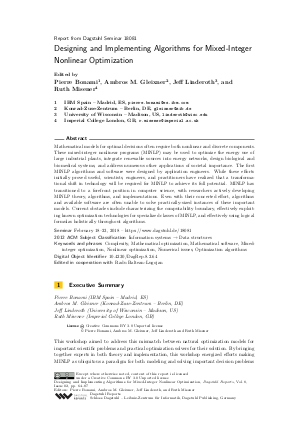Designing and Implementing Algorithms for Mixed-Integer Nonlinear Optimization (Dagstuhl Seminar 18081)
Authors Pierre Bonami, Ambros M. Gleixner, Jeff Linderoth, Ruth Misener and all authors of the abstracts in this report
-
Part of:
Issue:
Dagstuhl Reports, Volume 8, Issue 2
Part of: Volume: Dagstuhl Reports, Volume 8
Part of: Journal: Dagstuhl Reports (DagRep) - License:
 Creative Commons Attribution 3.0 Unported license
Creative Commons Attribution 3.0 Unported license
- Publication Date: 2018-07-20
File

PDF
DagRep.8.2.64.pdf
- Filesize: 8.73 MB
- 24 pages
Document Identifiers
Subject Classification
Keywords
- Complexity
- Mathematical optimization
- Mathematical software
- Mixed-integer optimization
- Nonlinear optimization
- Numerical issues
- Optimization algorithms
Metrics
- Access Statistics
-
Total Accesses (updated on a weekly basis)
0Document
0Metadata
Abstract
Mathematical models for optimal decisions often require both nonlinear and discrete components. These mixed-integer nonlinear programs (MINLP) may be used to optimize the energy use of large industrial plants, integrate renewable sources into energy networks, design biological and biomedical systems, and address numerous other applications of societal importance. The first MINLP algorithms and software were designed by application engineers. While these efforts initially proved useful, scientists, engineers, and practitioners have realized that a transformational shift in technology will be required for MINLP to achieve its full potential. MINLP has transitioned to a forefront position in computer science, with researchers actively developing MINLP theory, algorithms, and implementations. Even with their concerted effort, algorithms and available software are often unable to solve practically-sized instances of these important models. Current obstacles include characterizing the computability boundary, effectively exploiting known optimization technologies for specialized classes of MINLP, and effectively using logical formulas holistically throughout algorithms.
Cite As Get BibTex
Pierre Bonami, Ambros M. Gleixner, Jeff Linderoth, and Ruth Misener. Designing and Implementing Algorithms for Mixed-Integer Nonlinear Optimization (Dagstuhl Seminar 18081). In Dagstuhl Reports, Volume 8, Issue 2, pp. 64-87, Schloss Dagstuhl – Leibniz-Zentrum für Informatik (2018)
https://doi.org/10.4230/DagRep.8.2.64
BibTex
@Article{bonami_et_al:DagRep.8.2.64,
author = {Bonami, Pierre and Gleixner, Ambros M. and Linderoth, Jeff and Misener, Ruth},
title = {{Designing and Implementing Algorithms for Mixed-Integer Nonlinear Optimization (Dagstuhl Seminar 18081)}},
pages = {64--87},
journal = {Dagstuhl Reports},
ISSN = {2192-5283},
year = {2018},
volume = {8},
number = {2},
editor = {Bonami, Pierre and Gleixner, Ambros M. and Linderoth, Jeff and Misener, Ruth},
publisher = {Schloss Dagstuhl -- Leibniz-Zentrum f{\"u}r Informatik},
address = {Dagstuhl, Germany},
URL = {https://drops.dagstuhl.de/entities/document/10.4230/DagRep.8.2.64},
URN = {urn:nbn:de:0030-drops-92909},
doi = {10.4230/DagRep.8.2.64},
annote = {Keywords: Complexity, Mathematical optimization, Mathematical software, Mixed-integer optimization, Nonlinear optimization, Numerical issues, Optimization algorithms}
}
